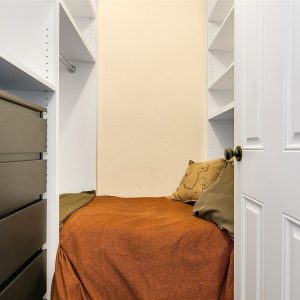The single most important factor in determining the market rent of an apartment is the number of bedrooms. People will pay additional rent for additional bedrooms, but little else. An apartment with a separate dining room will rent for the same amount as an apartment without a dining room. Therefore, landlords always try to maximize the number of bedrooms in an apartment that they are getting ready to rent. Sometimes, that isn’t hard to do. With just a little remodeling, like moving a wall or adding a door, a dining room can become a perfectly acceptable bedroom. (I’ve done that myself.) On the other hand, landlords sometimes call rooms ‘bedrooms’ that is just plain fraud. ‘Bedroom inflation’ is a term I created to describe the practice of inflating the number of bedrooms in a Craigslist apartment listing. Some landlords think that if you can put a bed in a room, then you can call it a bedroom, but that isn’t true. There are laws that define the minimum standards for a bedroom. Take a look at this listing photo.

The owner of this apartment counted this room as one of the bedrooms in his listing. It is, in fact, just a walk-in closet. Yes, it is a room, and the landlord has put a bed in it, but that doesn’t make it a bedroom. I tell landlords not to engage in this sort of deception. This isn’t going to fool anyone. Nobody is really going to think that this walk-in closet is actually a bedroom just because there’s a bed in it. This is just going to make prospective tenants angry. Everybody hates the feeling that someone is trying to play him for a sucker. The most common form of bedroom inflation is counting a living room as a bedroom. Because of the high rent and housing shortage here in Berkeley, a growing number of college students are sleeping on living room couches. However, just because somebody is sleeping on a futon in a living room doesn’t make that room a bedroom. A living room with somebody sleeping in it is still a living room. I always advise landlords to tell the truth. Its OK for a landlord to brag about the features in his apartment that will make it look more desirable to prospective tenants. I do that. All rational landlords do that. But that’s different than lying or trying to play prospective tenants for suckers. (As you can tell, bedroom inflation is one of my pet peeves.)
 I remember that commercial because it seemed so inappropriate. ‘Non-Stop’ is a movie about a terrorist and an alcoholic air marshal who shoot it out on an airplane while the plane is in flight. I seem to recall that there was also a suitcase full of cocaine on the airplane and a plot to kill the passengers one at a time. I thought that was a very poor choice for a commercial that people had to watch at an airport while waiting for their flights to take off. I remember thinking: “Didn’t the thought occur to somebody that this is a really bad movie to be advertising at an airport?”
I remember that commercial because it seemed so inappropriate. ‘Non-Stop’ is a movie about a terrorist and an alcoholic air marshal who shoot it out on an airplane while the plane is in flight. I seem to recall that there was also a suitcase full of cocaine on the airplane and a plot to kill the passengers one at a time. I thought that was a very poor choice for a commercial that people had to watch at an airport while waiting for their flights to take off. I remember thinking: “Didn’t the thought occur to somebody that this is a really bad movie to be advertising at an airport?” I remember that commercial because it seemed so inappropriate. ‘Non-Stop’ is a movie about a terrorist and an alcoholic air marshal who shoot it out on an airplane while the plane is in flight. I seem to recall that there was also a suitcase full of cocaine on the airplane and a plot to kill the passengers one at a time. I thought that was a very poor choice for a commercial that people had to watch at an airport while waiting for their flights to take off. I remember thinking: “Didn’t the thought occur to somebody that this is a really bad movie to be advertising at an airport?”
I remember that commercial because it seemed so inappropriate. ‘Non-Stop’ is a movie about a terrorist and an alcoholic air marshal who shoot it out on an airplane while the plane is in flight. I seem to recall that there was also a suitcase full of cocaine on the airplane and a plot to kill the passengers one at a time. I thought that was a very poor choice for a commercial that people had to watch at an airport while waiting for their flights to take off. I remember thinking: “Didn’t the thought occur to somebody that this is a really bad movie to be advertising at an airport?”



